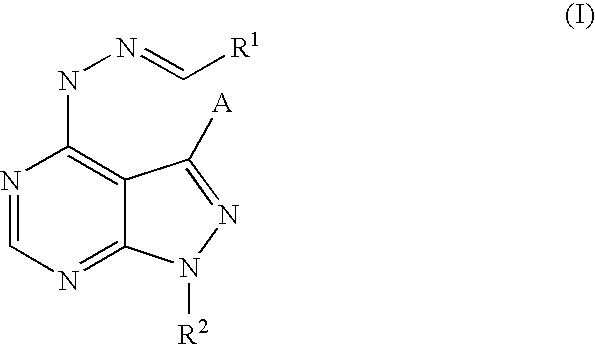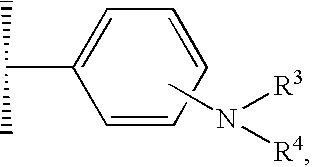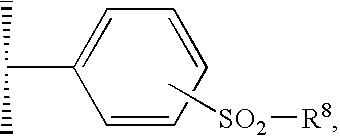Pyrazolopyrimidines as kinase inhibitors
a kinase inhibitor and pyrazolopyrimidine technology, applied in the field of pyrazolopyrimidine compounds, can solve the problems of affecting cell function or death, affecting the life cycle of viruses, and affecting the treatment effect of such disorders, and achieve the effect of treating or prophylaxis of such disorders
- Summary
- Abstract
- Description
- Claims
- Application Information
AI Technical Summary
Benefits of technology
Problems solved by technology
Method used
Image
Examples
##s example b
INTERMEDIATES EXAMPLE B
4-Hydrazino-1-pyridin-2-yl-1H-pyrazolo[3,4-d]pyrimidine
[0080]
a. 5-Amino-1-pyridin-2-yl-1H-pyrazole-4-carbonitrile
[0081] To 2-hydrazinopyridine (3.00 g, 27.5 mmol) in 50 mL of ethanol was added 2-(ethoxymethylene)malononitrile (3.37 g, 27.5 mmol) and triethylamine (3.8 mL,27.5 mmol). Mixture was refluxed of ca. 3.5 h. After cooling to RT the resulting solids were collected to give the product as a white solid (4.33 g, 85%).
[0082]1H NMR (DMSO) δ 8.46 (dd, 1H), 8.11 (brs, 2H), 8.01 (m, 1H), 7.88 (s, 1H), 7.84 (d, 1H), 7.35 (m, 1H) ppm.
b. 1-Pyridin-2-yl-1H-pyrazolo[3,4-d]pyrimidin-4-ol
[0083] 5-amino-1-pyridin-2-yl-1H-pyrazole-4-carbonitrile (b, above) (4.30 g, 23.2 mmol) was dissolved in 60 mL of formic acid and refluxed for ca. 22 h. The mixture was cooled to RT, concentrated under reduced pressure and diluted with ether. The resulting solid was collected by filtration and washed with ether to give the product as a white solid (4.71 g, 95%).
[0084]1H NMR (D...
##s example c
INTERMEDIATES EXAMPLE C
4-Hydrazino-1-(1,3-thiazol-2-yl)-1H-pyrazolo[3,4-d]pyrimidine
[0089]
a. 5-Amino-1-(1,3-thiazol-2-yl)-1H-pyrazole-4-carbonitrile
[0090] Ethoxymethylenemalononitrile (0.290 g, 2.38 mmol) was added to a solution of 2-hydrazino-1,3-thiazole (0.274 g, 2.38 mmol) in 10 mL of absolute ethanol. The mixture was heated at reflux for 2 hours. After cooling to room temperature, the solvent was evaporated under vacuum to give 0.448 g (98%) of a tan solid.
[0091]1H NMR (DMSO) δ 8.00 (br s, 2H), 7.95 (s, 1H), 7.65 (d, 1H), 7.55 (d, 1H) ppm.
[0092] ES-MS m / z 192 (MH+)
b. 1-(1,3-Thiazol-2-yl)-1H-pyrazolo[3,4-d]pyrimidin-4-ol
[0093] A mixture of 5-amino-1-(1,3-thiazol-2-yl)-1H-pyrazole-4-carbonitrile (a, above) (0.445 g, 2.33 mmol) and 10 mL of 88% formic acid was heated at 100° C. for 18 hours. After cooling to room temperature, diethyl ether was added and the precipitated solid was collected by filtration, washed with ether and dried under vacuum to give 0.350 g (69%) of prod...
##s example d
INTERMEDIATES EXAMPLE D
4-Hydrazino-1-pyridin-4-yl-1H-pyrazolo[3,4-d]pyrimidine
[0099]
a. 5-Amino-1-pyridin-4-yl-1H-pyrazole-4-carbonitrile
[0100] To a suspension of 4-hydrazinopyridine hydrochloride (2.5 g, 17.2 mmol) in ethanol (100 ml) were added 2-ethoxymethylenemalononitrile (2.6 g, 21.3 mmol) and triethylamine (3.2 ml, 23 mmol). The mixture was refluxed for 30 min, concentrated and purified by column chromatography with ethyl acetate to give clean product as a solid (2.0 g, 63% yield).
[0101]1H NMR(300 MHz, DMSO) δ 8.71 (d, 2H), 7.93 (s, 1H), 7.63 (d, 2H), 7.10 (s, 2H) ppm;
[0102] ES-MS m / z 186 (MH+).
b. 4-Chloro-1-pyridin-4-yl-1H-pyrazolo[3,4-d]pyrimidine
[0103] A solution of 5-amino-1-pyridin-4-yl-1H-pyrazole-4-carbonitrile (a, above) (2.0 g, 11 mmol) in 88% formic acid (50 mL) was stirred at 100° C. overnight. The solution was concentrated to 10 mL and ether was added. Solid was filtered, washed with ether (2×) and dried under vacuum. The resulting solid was dissolved in pho...
PUM
| Property | Measurement | Unit |
|---|---|---|
| concentration | aaaaa | aaaaa |
| concentration | aaaaa | aaaaa |
| pharmaceutical composition | aaaaa | aaaaa |
Abstract
Description
Claims
Application Information
 Login to View More
Login to View More - R&D
- Intellectual Property
- Life Sciences
- Materials
- Tech Scout
- Unparalleled Data Quality
- Higher Quality Content
- 60% Fewer Hallucinations
Browse by: Latest US Patents, China's latest patents, Technical Efficacy Thesaurus, Application Domain, Technology Topic, Popular Technical Reports.
© 2025 PatSnap. All rights reserved.Legal|Privacy policy|Modern Slavery Act Transparency Statement|Sitemap|About US| Contact US: help@patsnap.com



